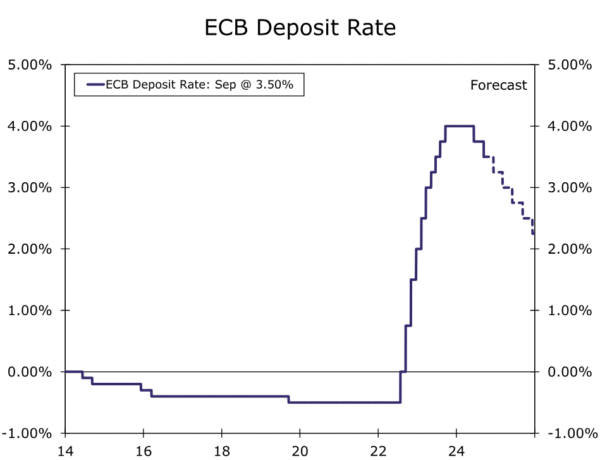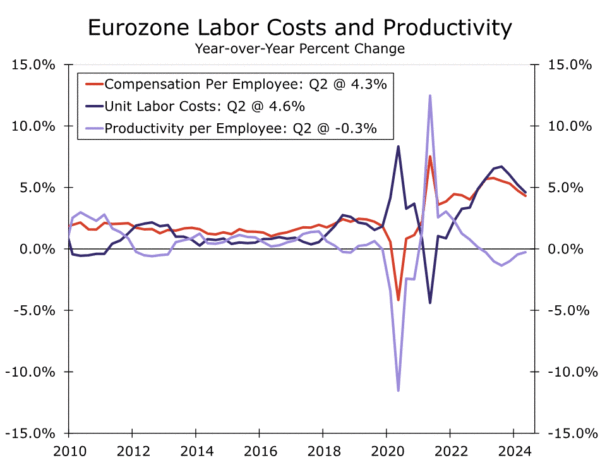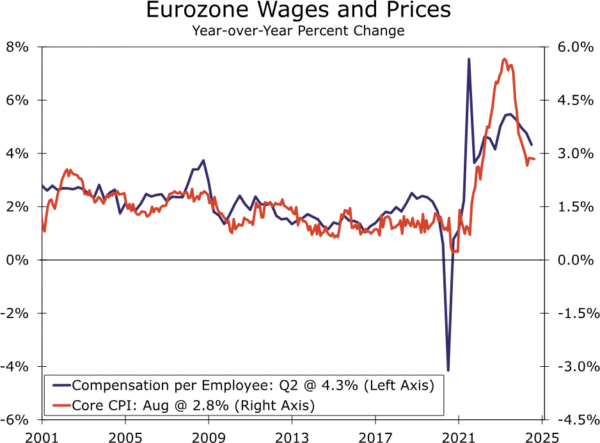Summary
The European Central Bank (ECB) delivered a widely expected 25 bps cut to its Deposit Rate to 3.50% at today’s monetary policy announcement, but remained relatively cautious about the pace of future easing. The ECB said domestic inflation and wages are elevated, but that labor cost pressures are moderating. The ECB was also guarded with regards to policy guidance, saying it remains data-dependent, and will take a meeting-by-meeting approach to its monetary policy decisions.
Regarding its economic projections, the ECB lowered its GDP growth forecasts but, importantly, revised its core CPI inflation forecasts slightly higher, in part due to persistent services inflation. Indeed, given the Eurozone productivity and cost backdrop, we believe the risks are tilted toward underlying inflation subsiding more slowly than generally expected. We remain comfortable with our view for an ECB rate pause in October, to be followed by a 25 bps Deposit rate cut in December, which would see the Deposit rate end 2024 at 3.25%. Our view also remains that the ECB will continue lowering its policy rate at a steady 25-bps-per-quarter pace (that is, every other meeting) in 2025, which would see the policy rate reach 2.25% by the end of next year.
European Central Bank Cuts Rates, Keeps Future Easing Options Open
The European Central Bank (ECB), as widely expected, cut its Deposit Rate by 25 bps to 3.50% at today’s monetary policy announcement. In lowering interest rates, the ECB described inflationary pressures as still elevated but moderating. Accordingly, the announcement included a mixture of both hawkish and dovish comments. The ECB said:
- Domestic inflation remains high as wages are still rising at an elevated pace, but also that labor cost pressures are moderating, and profits are partially buffering the impact of higher wages on inflation.
- The outlook for core inflation has been revised slightly higher, as services inflation has lingered.
- Financing conditions remain restrictive, and economic activity is still subdued, reflecting weak private consumption and investment.
The ECB was noncommittal regarding the future outlook for policy rates, saying it “will continue to follow a data-dependent and meeting-by-meeting approach to determining the appropriate level and duration of restriction” of its monetary policy stance. The ECB also said that it is “not pre-committing to a particular rate path.”
In terms of the ECB’s updated economic projections, the central bank lowered its GDP growth forecast for each and every year through its forecast horizon, and now sees Eurozone growth of 0.8% in 2024, 1.3% in 2025 and 1.5% in 2026. These are moderately softer than our own growth forecasts over the same period. Importantly, however, the ECB’s forecasts indicated a slower ebbing in underlying inflation pressures than previously. The ECB projects core CPI inflation (that is, CPI ex food and energy) of 2.9% for 2024 and 2.3% for 2025, a touch higher than in the June projections. The core CPI forecast for 2026 of 2.0% is unchanged, and in line with the ECB’s inflation target.
We also note some “hawkish leaning” comments from ECB President Lagarde in the post-meeting press conference. Lagarde said domestic inflation is not satisfactory and the ECB must be resilient in its approach. She also said there was a relatively short period of time until the ECB’s October monetary policy meeting. Considering ECB President Lagarde’s comments, and the upward revision to the ECB’s core inflation projections, we remain comfortable with our view for an ECB rate pause in October, to be followed by a 25 bps Deposit rate cut in December, which would see the ECB’s Deposit rate end 2024 at 3.25%.
Eurozone: Unimpressive Economic Growth, Lingering Inflation
Following a period of stagnation in the second half of last year, the Eurozone economy has returned to an expansion path during 2024, although the pace of growth has been unimpressive. Q2 GDP rose just 0.2% quarter-over-quarter and 0.6% year-over-year, and the underlying details were also subdued in tone. Q2 consumer spending actually fell 0.1% quarter-over-quarter, while much of the headline Q2 GDP growth stemmed from increased government spending and exports. Sentiment surveys have been mixed in recent months, although they did appear to get an Olympics-related boost in August, as the services PMI rose to 52.9 while the manufacturing PMI was steady at 45.8.
While economic indicators have been mixed, we believe the outlook remains for overall moderate and positive economic growth in the quarters ahead. With employment continuing to grow gradually, Eurozone real household income trends remain on a favorable path. For example, real employee compensation rose 2.5% year-over-year in Q2 while real household disposable income rose 2.6% in Q1, both well in excess of the 0.5% gain registered for consumer spending in Q2. Lower interest rates should ultimately be supportive of the Eurozone consumer, and we note that loans to households have picked up slightly in recent months.
The outlook for business investment is not quite as sanguine, given declining profit growth (that is, year-over-year declines in net entrepreneurial income) and falling capacity utilization. Our estimate of Eurozone core ex-housing investment fell 1.2% year-over-year in Q2, and the prospects for a sharp rebound in investment spending seem limited in the near term. That said, we believe an improving outlook for Eurozone consumers should outweigh the clouded outlook for businesses, and we believe Eurozone economic expansion can continue, albeit at a modest pace.
Even in the context of this underwhelming Eurozone growth outlook, lingering concerns about the inflation outlook, and how quickly inflation pressures are subsiding, have remained. Services inflation in particular has remained elevated, as pointed out in the ECB’s announcement, with the latest reading showing a 4.2% year-over-year gain in August. Wage pressures have started to diminish, with the Q2 compensation per employee slowing to 4.3% year-over-year and the ECB’s Indicator of Negotiated Wages slowing to 3.6%. Still, current wage growth trends remain above those that prevailed in the decade prior to the pandemic. Moreover, for now, current wage trends likely remain above levels that are consistent with underlying inflation returning to 2% on a sustained basis, particularly given the lack of any pickup in productivity. In terms of productivity, Q2 GDP per employed person actually fell 0.3% year-over-year, in contrast to average growth of 0.8% in the decade prior to the pandemic. We believe ECB policymakers will want to see a further slowing in wage growth, and/or improvement in productivity, to become increasingly confident that domestic inflationary pressures are subsiding. Indeed, in the current productivity and cost backdrop, we see risks that underlying inflation pressures subside more slowly than generally expected. For these reasons, and unless and until the productivity and cost backdrop changes, our view remains that the European Central Bank will continue lowering its policy rate at a steady 25-bps-per-quarter pace (that is, every other meeting), which would see the policy rate reach 2.25% by the end of next year.


















